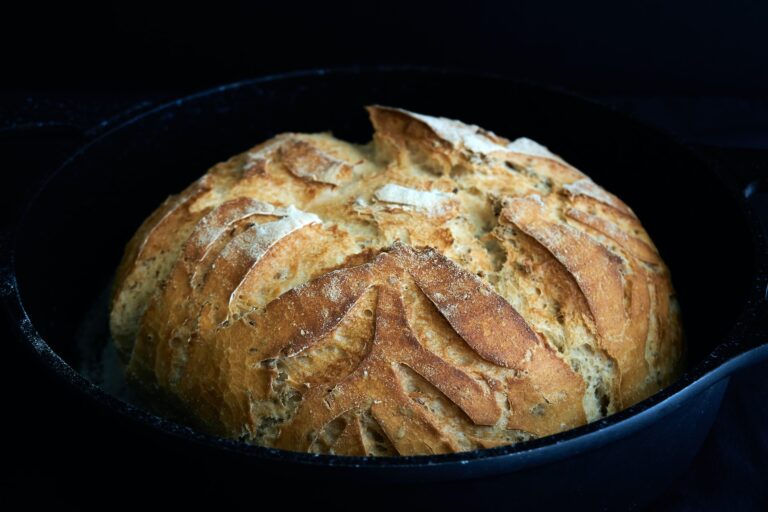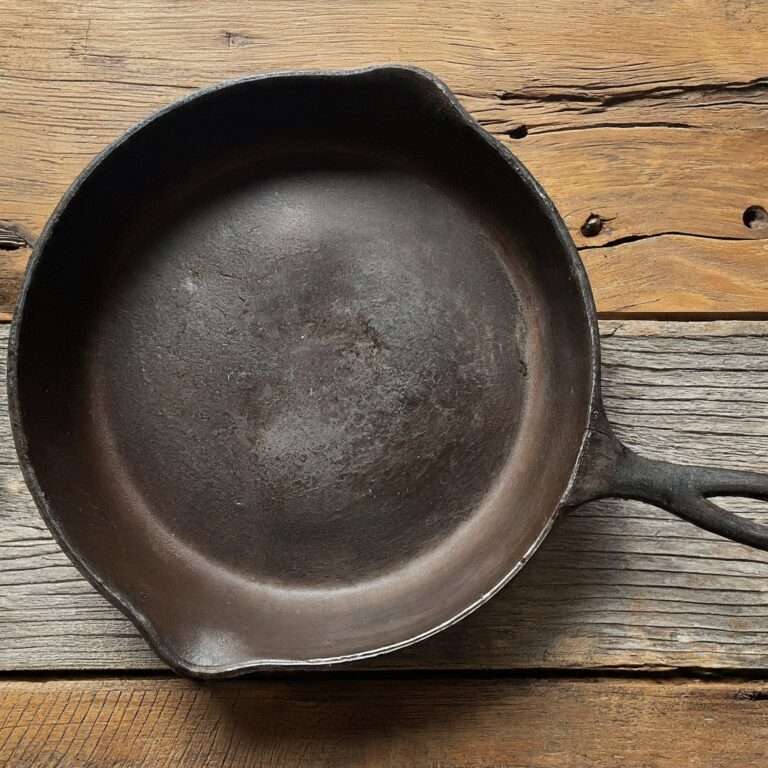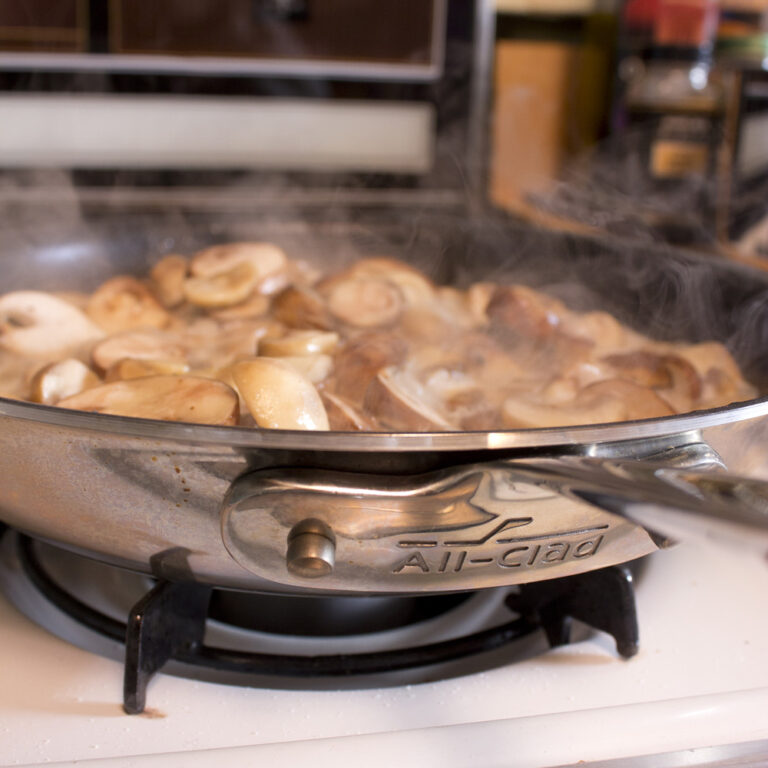Are you wondering if you should wash your new pots and pans? It might seem unnecessary, but taking the time to clean them before using is essential.
This article will explore the potential contaminants that could be lurking on your new cookware and the health risks of not washing them.
You’ll also learn the best cleaning methods and get expert opinions on whether you can trust the manufacturer’s pre-wash.
Don’t miss out on these important tips for properly washing your new cookware.
Key Takeaways
- Washing new pots and pans is essential to remove potential toxins or allergens.
- Harmful chemicals like lead, cadmium, PFOA, and phthalates can be present in new cookware.
- Maintaining clean and hygienic kitchen utensils, including pots and pans, is crucial for food safety.
- Not washing new cookware can lead to health risks for you and your family.
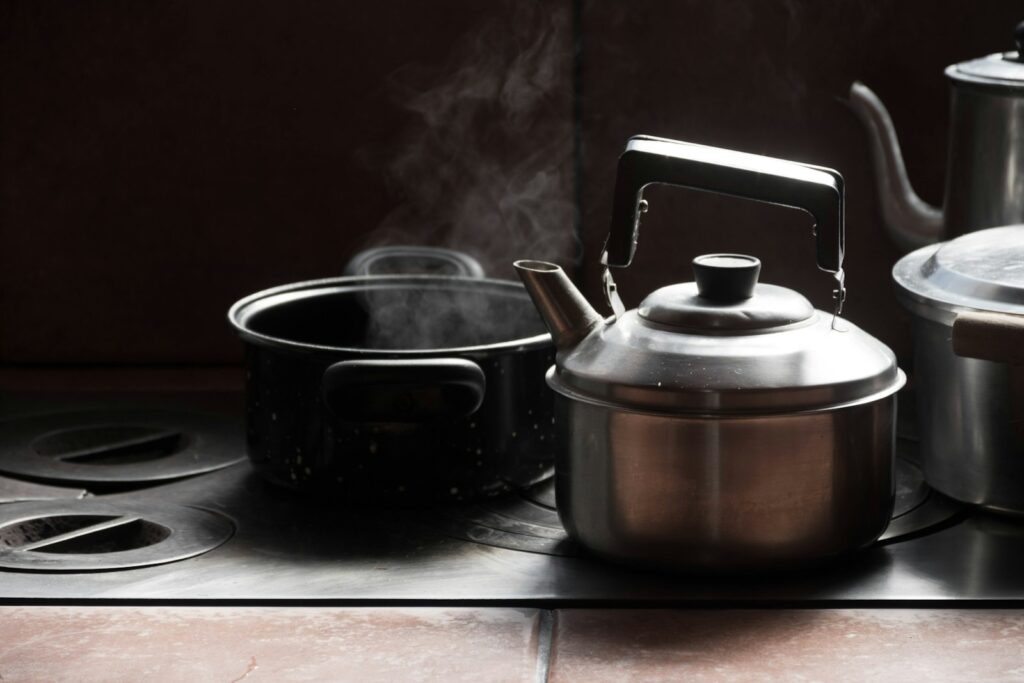
The Importance of Washing New Pots and Pans
You should definitely wash your new pots and pans before using them. This is important because there are potential health risks associated with using unwashed cookware. When pots and pans are manufactured, they may come into contact with various chemicals, residues, or contaminants that could be harmful if ingested.
By washing them before use, you can remove any potential toxins or allergens, ensuring a safer cooking experience. Additionally, pre-washing your new pots and pans helps to remove any dust, debris, or manufacturing residues that may be present.
This not only improves the overall cleanliness of your cookware but also ensures that you’re cooking with clean and uncontaminated utensils. In conclusion, the benefits of pre-washing your new pots and pans far outweigh any inconvenience, as it helps to eliminate potential health risks and ensures a clean cooking environment.
Potential Contaminants on New Cookware
Before you start cooking with your new pots and pans, it’s important to be aware of potential contaminants that may be present. Harmful chemicals such as lead, cadmium, and PFOA can sometimes be found in the coatings or materials used in cookware.
These contaminants can pose risks to your health and food safety.
Harmful Chemicals Present
There are harmful chemicals present in new pots and pans that you should be aware of. When purchasing new cookware, it’s important to consider the potential contaminants that may be lurking in them. Here are four harmful chemicals commonly found in new pots and pans:
- PFOA (perfluorooctanoic acid): This chemical is used in the production of nonstick coatings and has been linked to various health issues, including cancer.
- Lead: Some cookware may contain lead, which can leach into your food and cause serious health problems, particularly in children.
- Cadmium: This toxic metal is often found in the glazes used on ceramic cookware and can contaminate your food if it chips or cracks.
- Phthalates: These chemicals are used to make plastics more flexible and can potentially migrate into your food, disrupting hormonal balance.
Food Safety Concerns
When cooking, it’s important to ensure the safety of your food by being mindful of potential contaminants and following proper food handling practices. One of the key aspects of food safety is maintaining clean and hygienic kitchen utensils, including pots and pans.
To prevent any potential foodborne illnesses, it’s crucial to clean your new pots and pans before using them. While they may appear clean on the surface, they could have been exposed to various contaminants during the manufacturing and packaging processes. By washing them thoroughly with hot soapy water and a sponge or brush, you can eliminate any potential residues or bacteria that might be present.
Regular cleaning methods, such as rinsing with hot water and using dish soap, can significantly reduce the risk of food contamination. So, always prioritize food safety by practicing proper cleaning methods for your pots and pans.
Cleaning Before Use?
To ensure the safety of your meals, it’s crucial to clean your kitchen utensils thoroughly before using them. Here are some potential benefits of cleaning your kitchen utensils before use:
- Eliminate dirt and debris: Washing your utensils removes any dirt, dust, or debris that may have accumulated during storage or transportation.
- Remove chemical residues: Cleaning your utensils helps to get rid of any potential chemical residues that might be present from the manufacturing process.
- Prevent cross-contamination: By washing your utensils, you can prevent cross-contamination between different foods and reduce the risk of foodborne illnesses.
- Maintain the quality of your meals: Clean utensils ensure that your meals taste better and are free from any unwanted flavors or odors.
While there are alternative methods, such as using dishwasher or sanitizing solutions, handwashing with warm water and soap remains the most effective way to clean your kitchen utensils.
Health Risks of Not Washing New Cookware
Not washing new cookware can pose health risks to you and your family. Bacteria can be present on the surface of new pots and pans, which can lead to foodborne illnesses if not properly cleaned.
Additionally, there may be chemical residues from the manufacturing process that can leach into your food when cooking, potentially causing harm to your health.
Bacteria on New Cookware
You should be aware that new pots and pans might have bacteria on them. While they may look clean and shiny, there’s still a risk of bacteria growth on the surface. To ensure the safety of your food and maintain good hygiene practices, it’s important to wash new cookware thoroughly before using it.
Here are four reasons why:
- Eliminate manufacturing residue: During the production process, pots and pans can accumulate dust, dirt, and chemicals. Washing them removes any potential contaminants that could be harmful to your health.
- Remove packaging germs: Cookware is often stored in warehouses or transported in boxes, which can expose it to various bacteria. Washing it before use helps eliminate any germs that may have been transferred during packaging.
- Remove handling bacteria: Workers in factories or stores may handle the cookware before it reaches your hands. Washing it removes any bacteria they may have left behind.
- Prevent cross-contamination: Even if the cookware appears clean, it may have come into contact with other items that weren’t properly sanitized. Washing it reduces the risk of cross-contamination and keeps your kitchen safe.
Chemical Residue Concerns
Be cautious of potential chemical residue on your cookware, as it could pose health risks if not properly washed before use. When manufacturing pots and pans, various chemicals and coatings are often applied to enhance their performance or appearance. However, these substances may leave behind residue that can be harmful if ingested.
To ensure your safety, it’s essential to remove any residue before cooking. There are several residue removal techniques you can employ. Firstly, wash your new cookware with warm water and dish soap, using a soft sponge or cloth to scrub away any residue. Additionally, vinegar or baking soda can be effective in removing stubborn residue.
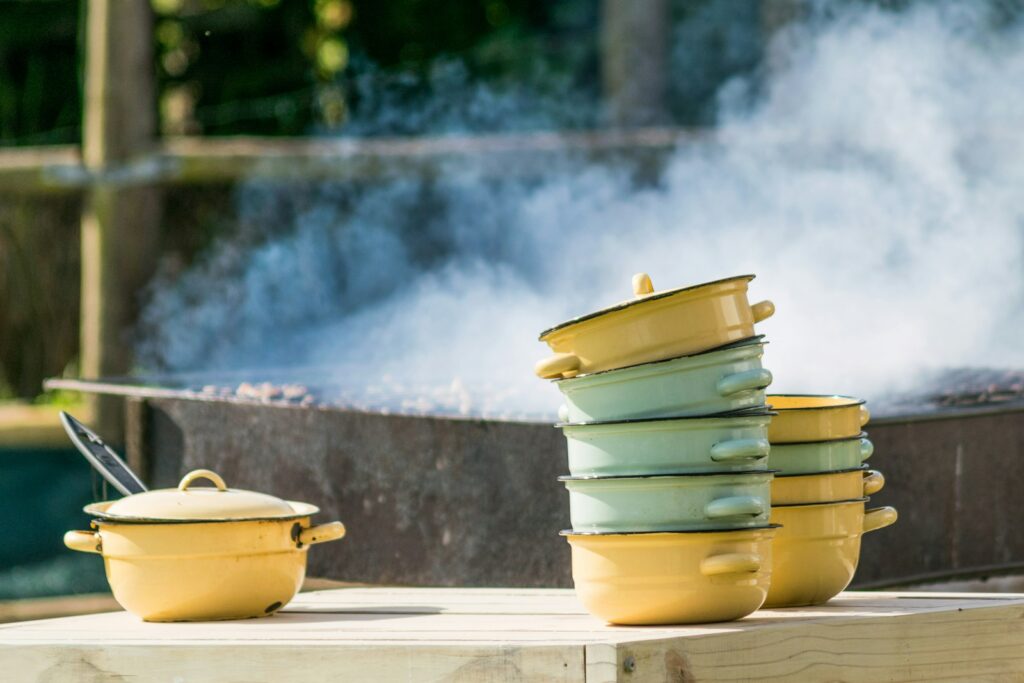
Cleaning Methods for New Pots and Pans
You’ll want to consider the best cleaning methods for your new pots and pans. Taking proper care of your cookware won’t only help them last longer but also ensure that your food is safe to eat.
Here are some cleaning techniques and recommended cleaning products to keep your new pots and pans in great condition:
- Handwashing: It’s generally recommended to wash your new pots and pans by hand using warm, soapy water. This helps prevent any damage that can occur in the dishwasher.
- Non-abrasive scrubbers: Use non-abrasive scrubbers or sponges to avoid scratching the surface of your new cookware. This will help maintain their appearance and performance.
- Avoid harsh chemicals: Stay away from harsh cleaning chemicals, as they can damage the coating or seasoning on your pots and pans. Stick to mild dish soap and water for regular cleaning.
- Vinegar and baking soda: For stubborn stains or burnt-on food, try using a mixture of vinegar and baking soda. This natural solution can help remove tough residues without damaging the cookware.
Tips for Properly Washing New Cookware
To properly clean your newly acquired cookware, remember to use non-abrasive scrubbers and mild dish soap. Cleaning techniques for new pots and pans are important to maintain their quality and longevity.
Start by rinsing them with warm water to remove any dust or residue. Then, apply a small amount of mild dish soap and gently scrub the surface using a non-abrasive scrubber. This will help remove any grease or stains without scratching the cookware.
Rinse thoroughly with warm water to ensure all soap residue is removed. It’s recommended to avoid using harsh chemicals or abrasive scrubbers, as they can damage the surface of your cookware.
Should You Trust the Manufacturer’s Pre-Wash
If the manufacturer’s pre-wash isn’t thorough, leftover residues might affect the quality of your cookware. So, should you trust the manufacturer’s pre-wash? Here are some discussion ideas to consider:
Potential risks of relying on manufacturer’s pre-wash:
- Inadequate removal of manufacturing chemicals or residues
- Possible contamination from storage and transportation processes
- Health concerns due to unknown substances used in the pre-wash
Alternatives to trusting the manufacturer’s pre-wash:
- Wash the cookware yourself before use to ensure cleanliness and safety
- Use natural cleaning agents like vinegar or baking soda to remove any potential residues
- Consult the manufacturer’s instructions for specific cleaning recommendations
- Consider purchasing cookware from manufacturers known for their quality pre-washing processes
Ultimately, the choice is yours. By being aware of the potential risks and exploring alternative options, you can make an informed decision about whether to trust the manufacturer’s pre-wash.
Common Misconceptions About Washing New Cookware
Don’t overlook the importance of thoroughly cleaning your newly purchased cookware. While it may seem tempting to skip this step and trust the manufacturer’s pre-wash, doing so could pose potential health risks. It’s essential to understand that even if the cookware appears clean, it may still harbor harmful contaminants.
To ensure your safety and the longevity of your cookware, it’s crucial to follow proper cleaning techniques. Here are three commonly recommended cleaning techniques for new cookware:
| Cleaning Technique | Materials Required | Steps |
|---|---|---|
| Soaking | Warm water, mild dish soap | 1. Fill sink with warm soapy water |
| Sponge or soft brush | 2. Submerge cookware and let soak | |
| 3. Scrub gently with sponge or brush | ||
| 4. Rinse thoroughly with clean water | ||
| 5. Dry with a soft cloth | ||
| Vinegar Solution | White vinegar, water | 1. Mix equal parts vinegar and water |
| Sponge or soft cloth | 2. Apply solution to cookware | |
| 3. Let sit for a few minutes | ||
| 4. Scrub gently with sponge or cloth | ||
| 5. Rinse thoroughly with clean water | ||
| 6. Dry with a soft cloth | ||
| Baking Soda Paste | Baking soda, water | 1. Mix baking soda and water to form a paste |
| Sponge or soft brush | 2. Apply paste to cookware | |
| 3. Let sit for 15-20 minutes | ||
| 4. Scrub gently with sponge or brush | ||
| 5. Rinse thoroughly with clean water | ||
| 6. Dry with a soft cloth |
Expert Opinions on Washing New Pots and Pans
When it comes to cleaning your newly purchased cookware, experts recommend following specific techniques to ensure its cleanliness and safety. Here are some recommended practices for the cleaning process:
- Wash with warm, soapy water: Start by rinsing your new pots and pans with warm water to remove any loose particles. Then, use a mild dish soap and a sponge or cloth to thoroughly clean the surfaces.
- Avoid harsh abrasives: It’s important to avoid using harsh scrub brushes or abrasive cleaners, as they can damage the surface of your cookware. Stick to soft sponges or non-abrasive cleaning pads.
- Dry thoroughly: After washing, make sure to dry your pots and pans completely to prevent any water spots or rust from forming. Use a clean towel or air dry them upside down.
- Season cast iron cookware: If you’ve purchased cast iron cookware, it’s recommended to season it before use. This involves applying a thin layer of oil and heating it to create a non-stick surface.
Conclusion
In conclusion, it’s highly recommended to wash new pots and pans before using them. There may be potential contaminants on the cookware that could pose health risks if not properly cleaned.
Following the proper cleaning methods and not relying solely on the manufacturer’s pre-wash is essential. By taking the time to wash your new cookware, you can ensure a safe and enjoyable cooking experience.


